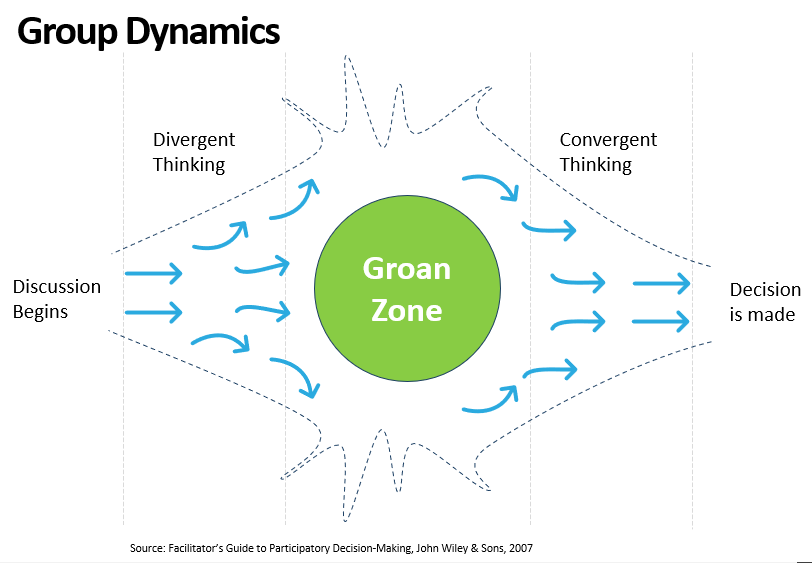How frequently do you leave a collaborative workshop or meeting feeling frustrated that nothing was really accomplished?
There may have been a lot of great discussions, but people kept going off on tangents. Maybe too many ideas were proposed, and it was impossible to focus and prioritize.
We asked this same question during a recent webinar and were surprised by the results:
Our respondents indicated 85% leave some or most project meetings feeling that nothing was accomplished!

Source: The Importance of Facilitation Skills in Capital Project Workshops (webinar), Construction Industry Institute, Valency Inc., December 2021
This is a classic example of where a skilled facilitator can contribute to a more productive discussion and greatly improve a collaborative, group decision-making process.
The reality of group decision making is that it is not a straight line from idea generation to decision.
In a group decision-making process, most people who are engaged will bring forward ideas. These ideas may not all be well communicated or fully understood by the group. With the varying generated ideas, it can be difficult for a group to come to a final decision. This is where the role of a facilitator can help guide the group from idea generation to decision with the group decision-making zones.
This diagram illustrates how group decision-making really works when we have difficult problems to solve. The facilitator will lead the group into the Divergent thinking zone, then the Groan Zone and finally through the Convergent thinking zone.

Divergent Thinking
The first step to group decision-making is the Divergent thinking zone which is a brainstorming exercise to generate as many ideas as possible. As the discussion beings, people in the group will generally start by sharing safe ideas and familiar options. This is the opportune time as a facilitator to ensure that the group feels safe, encouraging them to share partially developed or controversial ideas. Allowing the group enough time to explore a wide range of possibilities conduct richer conversations can lead to more creative concepts and ideas to contribute to the outcome.
Groan Zone
Once the group has generated a collection of ideas, the facilitator can lead the workshop into what is known as the Groan zone. This is where the ideas collected are discussed and categorized which requires the group to consider more diverse perspectives. Trying to understand a wider range of new and sometimes opposing ideas can be difficult and lead to misunderstanding and miscommunication. This is where a skilled facilitator can encourage discussion to seek clarification on misunderstanding and guide the group through the process of fleshing out their ideas. This phase, though uncomfortable really promotes a shared understanding and the inputs collected gain value from the collaboration of the group.
Convergent Thinking
After working through the Groan zone, the group progresses to the Convergent thinking zone. This is where the ideas and concepts that were brought forward begin to shape into workable ideas. Once the group has developed a framework to evaluate and prioritize ideas, the pace of the discussion will accelerate. The overall confidence level amongst the group members will build, which in turn increases group alignment and allows for the group to reach a decision.
There are many skills and techniques that a facilitator can employ within each of the three stages (Divergent zone, Groan zone, Convergent thinking zone) to bring the group to a final decision and a path forward.
Group decision-making can be daunting as it is complex. Having the support of a skilled facilitator is one of the most effective ways to ensure a productive outcome to capital project workshops. When the project team maintain strong team alignment throughout the lifecycle of a project.

